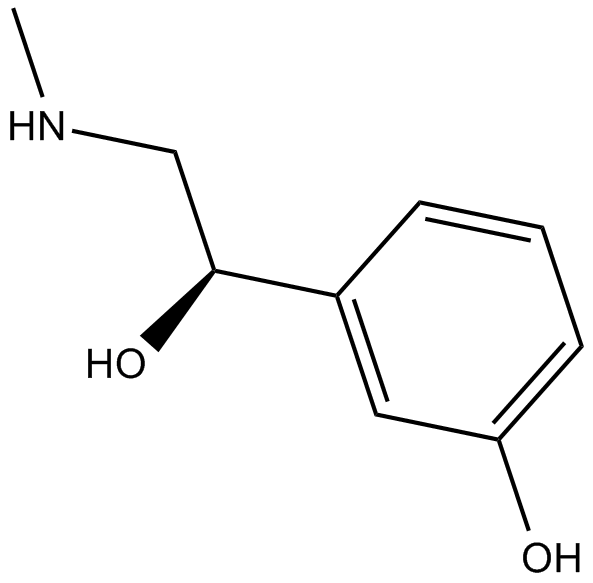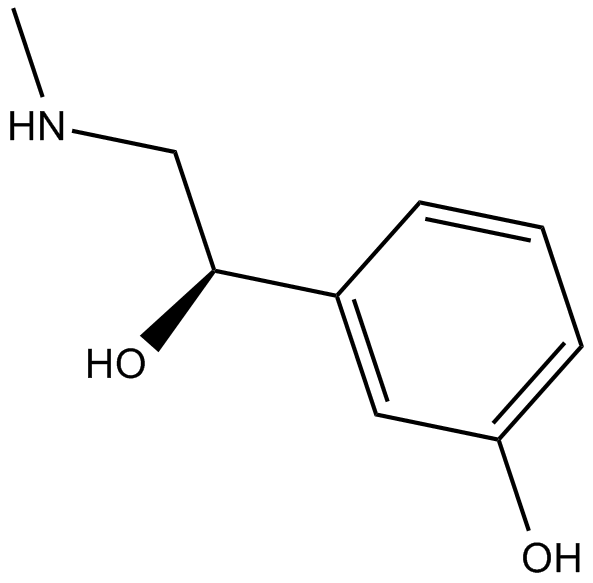L-Phenylephrine
Target: adrenergic α1A receptor
Ki: 1.4 μM
L-Phenylephrine is a selective agonist of adrenergic α1A receptor, with the Ki value of 1.4 μM, while having less effect against the α1B and α1C receptor subtypes, with the Ki values of 23.9 μM and 47.8 μM, respectively [1].
In Vitro: In neonatal rat cardiomyocytes, 50 μM L-Phenylephrine treatment could protect cells from apoptosis induced by hypoxia (95% N2 and 5% CO2) and serum deprivation through α-adrenergic receptor stimulation [2]. Besides, in neural progenitor cells (NPCs), 10 μM L-Phenylephrine could increase NPCs proliferation by approximately 160% [3]. Furthermore, in cultured rat neonatal CMs (NCMs), L-Phenylephrine could increase cross-sectional area, and significantly increase IL-6 mRNA levels, while decreasing PGC1α mRNA levels [4].
In Vivo: Studies in Sprague-Dawley male rats found that, local infiltration of L-phenylephrine could induce cutaneous anesthesia in a dose dependent manner, which could be significantly inhibited by α1-adrenergic receptor antagonists [5].
Clinical trial: Based on 8 unpublished studies that included 138 patients with nasal congestion, oral administration with 25 mg L-Phenylephrine could significantly reduce maximal nasal airway resistance (NAR) compared with placebo of 27.6% (95% CI 17.5% to 37.7%) [6].
References:
[1] Lomasney J W, Cotecchia S, Lorenz W, et al. Molecular cloning and expression of the cDNA for the alpha 1A-adrenergic receptor. The gene for which is located on human chromosome 5.[J]. Journal of Biological Chemistry, 1991, 266(10): 6365-6369.
[2] Zhu H, Mcelweewitmer S, Perrone M, et al. Phenylephrine protects neonatal rat cardiomyocytes from hypoxia and serum deprivation-induced apoptosis.[J]. Cell Death & Differentiation, 2000, 7(9): 773-784.
[3] Hiramoto T, Ihara Y, Watanabe Y, et al. α-1 Adrenergic receptors stimulation induces the proliferation of neural progenitor cells in vitro[J]. Neuroscience Letters, 2006, 408(1): 25-28.
[4] Planavila A, Redondo I, Hondares E, et al. Fibroblast growth factor 21 protects against cardiac hypertrophy in mice[J]. Nature Communications, 2013.
[5] Shieh J, Chu C, Wang J, et al. Epinephrine, phenylephrine, and methoxamine induce infiltrative anesthesia via α1-adrenoceptors in rats[J]. Acta Pharmacologica Sinica, 2009, 30(9): 1227-1236.
[6] Hatton R C, Winterstein A G, Mckelvey R P, et al. Efficacy and Safety of Oral Phenylephrine: Systematic Review and Meta-Analysis[J]. Annals of Pharmacotherapy, 2007, 41(3): 381-390.
| Storage | Store at -20°C |
| M.Wt | 167.2 |
| Cas No. | 59-42-7 |
| Formula | C9H13NO2 |
| Synonyms | (R)-(-)-Phenylephrine |
| Solubility | ≥16.8 mg/mL in H2O; ≥17.2 mg/mL in EtOH; ≥8.65 mg/mL in DMSO |
| Chemical Name | 3-hydroxy-αR-[(methylamino)methyl]-benzenemethanol |
| SDF | Download SDF |
| Canonical SMILES | OC1=CC=CC([C@@H](O)CNC)=C1 |
| Shipping Condition | Small Molecules with Blue Ice, Modified Nucleotides with Dry Ice. |
| General tips | We do not recommend long-term storage for the solution, please use it up soon. |
Quality Control & MSDS
- View current batch:
Chemical structure

Related Biological Data

Related Biological Data

Related Biological Data








